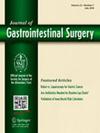Thrombosis and anticoagulation after portal vein reconstruction during pancreatic surgery: a systematic review
IF 2.2
3区 医学
Q3 GASTROENTEROLOGY & HEPATOLOGY
引用次数: 0
Abstract
Background
Portal vein (PV) resection and reconstruction, which includes the resection and reconstruction of the PV and superior mesenteric vein, enable surgical removal of borderline resectable and locally advanced pancreatic cancer. Thrombosis of the reconstructed PV represents a major cause of early postoperative and long-term morbidity and mortality. No universally accepted standard for anticoagulation exists. This study aimed to assess early and late thrombosis rates after PV reconstruction with special regard to the type of PV reconstruction and anticoagulation regimen and to comprehensively assess thrombotic events and their clinical effect in patients receiving pancreatic surgery with venous resection and reconstruction.
Methods
The Preferred Reporting Items for Systematic Reviews and Meta-Analyses guidelines were followed. Studies reporting on PV resection and reconstruction providing data on thrombosis rates were included. The following parameters were assessed: study type, year of publication, number of patients, type/number of PV reconstruction, follow-up period, postoperative mortality, thrombosis rate of the reconstructed PV axis, intraoperative blood loss, and anticoagulation.
Results
A total of 23 studies with 2751 patients were included in the final analysis. Of note, 670 patients received tangential resection of the PV with venorrhaphy or patch repair, 1505 patients had segmental resection with end-to-end reconstruction, and 576 patients received reconstruction with an interposition graft/conduit. The pooled overall thrombosis rate was 15%. Reconstruction of tangential defects with either venorrhaphy or patch repair and end-to-end repair of segmental defects resulted in a thrombosis rate of 12%. Subgroup analysis according to the type of graft reconstruction revealed the highest occlusion rates of 55% in patients with allogeneic grafts, followed by up to 27% in patients with synthetic PV conduits. Autologous conduits had a thrombosis rate of 10%. Early thrombotic events were detected in 5% of patients after venorrhaphy/patch reconstruction and end-to-end reconstruction. Early events were most common in the allogeneic graft subgroup (22%), followed by synthetic conduits (15%). There were fewer early events in the autologous graft group (7%). Early PV thrombosis was associated with relevant mortality of up to 26%. Anticoagulation regimens varied between studies.
Conclusion
The overall thrombosis rate after PV resection is low. However, among the different reconstruction techniques, allogeneic interposition grafts/conduits had the highest thrombosis rates among the different types of reconstruction after PV resection. No specific anticoagulation strategy can be considered beneficial based on the existing literature.
胰腺手术中门静脉重建后的血栓形成和抗凝治疗 - 系统综述。
摘要全面评估接受静脉切除和重建胰腺手术患者的血栓事件及其临床影响:背景:门静脉(PV,包括门静脉和肠系膜上静脉)切除和重建可用于手术切除边缘可切除和局部晚期胰腺癌。重建后的门静脉血栓形成是术后早期和长期发病率及死亡率的主要原因。目前还没有公认的抗凝标准。在此,我们旨在评估PV重建后的早期和晚期血栓形成率,并特别关注PV重建的类型以及抗凝方案:方法:遵循 PRISMA 指南。方法:遵循 PRISMA 指南,纳入报告了 PV 切除和重建并提供血栓形成率数据的研究。对以下参数进行了评估:研究类型、发表年份、患者人数、PV 重建类型/数量、随访时间、术后死亡率、重建 PV 轴的血栓形成率、术中失血量和抗凝治疗。670名患者接受了切向切除上静脉并进行静脉造口术或补片修补术,1505名患者进行了节段切除并进行了端对端重建,576名患者接受了插管移植/导管重建。总血栓形成率为 15%。采用静脉造口术或补片修复术重建切向缺损以及端对端修复节段性缺损的血栓形成率为12%。根据移植物重建类型进行的分组分析显示,异体移植物患者的闭塞率最高,为 55%,其次是合成 PV 导管患者,高达 27%。自体导管的血栓形成率为 10%。在静脉出血/补片重建和端对端重建后,5% 的患者发现了早期血栓事件。早期血栓事件在异体移植物亚组中最为常见(22%),其次是合成导管(15%)。自体移植物组的早期事件较少(7%)。早期 PV 血栓与高达 26% 的相关死亡率有关。不同研究的抗凝方案各不相同:结论:门静脉切除术后血栓形成的总体发生率较低。结论:门静脉切除术后血栓形成的总体发生率较低,但在不同的重建技术中,同种异体移植物/导管的血栓形成率最高。迷你摘要:胰腺手术中门静脉切除术后重建门静脉(PV)的血栓形成是主要发病率和死亡率的一个相关来源。在这篇系统性综述中,我们观察到门静脉切除术后的血栓形成率总体较低,但使用异体移植物重建门静脉的术后血栓形成风险最高。使用异体移植物重建后,早期血栓形成最为常见,并与术后死亡率相关。不同研究的抗凝策略差异很大。
本文章由计算机程序翻译,如有差异,请以英文原文为准。
求助全文
约1分钟内获得全文
求助全文
来源期刊
CiteScore
5.50
自引率
3.10%
发文量
319
审稿时长
2 months
期刊介绍:
The Journal of Gastrointestinal Surgery is a scholarly, peer-reviewed journal that updates the surgeon on the latest developments in gastrointestinal surgery. The journal includes original articles on surgery of the digestive tract; gastrointestinal images; "How I Do It" articles, subject reviews, book reports, editorial columns, the SSAT Presidential Address, articles by a guest orator, symposia, letters, results of conferences and more. This is the official publication of the Society for Surgery of the Alimentary Tract. The journal functions as an outstanding forum for continuing education in surgery and diseases of the gastrointestinal tract.

 求助内容:
求助内容: 应助结果提醒方式:
应助结果提醒方式:


